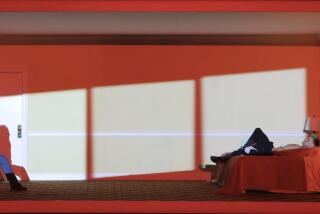<i> The Obedient Wife</i>
- Share via
The Obedient Wife by Julia O’Faolain
(Carroll & Graf: $17.95; 230 pp.)
Three decades ago, in a memorable short story, Sean O’Faolain dealt skillfully with the impingement of celibacy on a growing friendship, or comradeship, between two young monks and two young nuns during a Gaelic-studying summer session in the Irish mountains in the early 1920s. Things have changed a lot since the early 1920s, and the slopes of Beverly Glen, that well-known, well-off L.A. enclave, are a long way from the Irish mountains; but some things don’t change all that much between 1925 (or even 1355, approximate date of the “Decameron”) and 1985; and so today we have Julia O’Faolain (pronounced “Oh-FAY-l ‘n”), Sean’s daughter, skillfully dealing with the impingement on celibacy of a growing friendship or companionship between or among a young priest, a married parishioner with five children, and her secular-minded friend Carla, central figure of Julia’s new novel. Why Sybil Steele--the Steeles have given up sex because of not wanting more kids after the first five--should imagine that an affair with a virginal male presumably as ignorant of birth-control techniques as she must be herself (though her husband Terry “hates priests” he is always blasting away as anchorman on the local radio station in favor of every reactionary cause imaginable, so presumably both Steeles are equally unchecked-out on things everybody over 30 must know about in the 1980s!)--why Sybil should imagine such an affair could result in anything but five more sequences of “petty meannesses . . . squabbles . . . rivalries, egotism . . . every one grabbing what they can” (the very thing she objects to in her present home life, the thing that has driven her into church work and Terry into nightly radio broadcasting to get out of the house)--why she should imagine this is a real mystery, but logic and practicality aren’t Sybil Steele’s long suits, and in the novel’s opening scene she comes to Carla’s house in Beverly Glen apparently to borrow it for an erotic encounter not yet even suspected (far from contemplated!) by priest Leo (named for a famous Pope), who little guesses his immediate future.
The second thing the two O’Faolains have in common is strong interest in setting. Sean’s misty mountains, finely rendered in the short story, wonderfully foreshadow Julia’s sure touch with the Glen world, where religious freaks (?--or Satanists’ covens?) disembowel pet rabbits or cruelly crucify cats on cactuses, while half-wild Okie 13-year-old gamines build tree houses beyond Carla’s chain link fence, to share with Carla’s son Maurizio, whom an Iranian schoolmate at the L.A. French lycee has invited home to share Aladdin’s Olympic-size pool beside the family’s French-style chateau complete with spiked gates and private shooting gallery, while in a wet winter, rattlesnakes wash down into suburban backyards, graveyards deposit their flooded-out dead along highways, and Maurizio’s “worry was back, since Aladdin had knocked his head on the floor of the pool and maybe turned himself into a vegetable . . . “ (Mauruizio’s other worry is lest Cass, Polish refugee formerly living with Carla’s ex-movie-star neighbor Jane and now living with Wanda, the gamine’s mother, may really have his eye on the gamine. A sort of West Coast Humbert Humbert, he lived before the Jane period with a doped-up pre-adolescent until her parents enticed her home and shipped her off to reform school; but Maurizio decides that “if that guy gets fresh with her (the gamine) she’d probably shout the news out over the rooftops--she’d probably phone in and tell it on the Terry Steele show”).
The third O’Faolain specialty is a dab hand with titles. “The Man Who Invented Sin,” Sean’s name for his short story (and for a 1948 collection) neatly recalls Mark Twain (“The Man Who Corrupted Hadleyburg”); while the deadpan with of the title “The Obedient Wife” would (and should) have caught the instant attention of Boccaccio, Moliere, or G. B. Shaw. Don’t miss Julia’s latest novel, the best thing of its kind I’ve read since Alison Lurie’s “The Nowhere City.”
More to Read
Sign up for our Book Club newsletter
Get the latest news, events and more from the Los Angeles Times Book Club, and help us get L.A. reading and talking.
You may occasionally receive promotional content from the Los Angeles Times.








